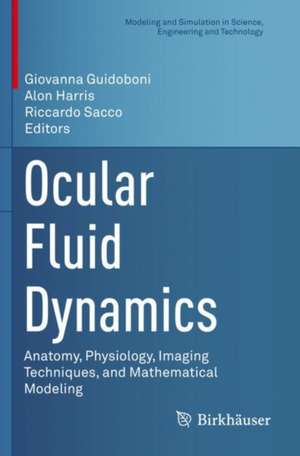Ocular Fluid Dynamics: Anatomy, Physiology, Imaging Techniques, and Mathematical Modeling: Modeling and Simulation in Science, Engineering and Technology
Editat de Giovanna Guidoboni, Alon Harris, Riccardo Saccoen Limba Engleză Paperback – 4 ian 2021
The chapters in this contributed volume showcase current theoretical approaches in the modeling of ocular fluid dynamics in health and disease. By including chapters written by experts from a variety of fields, this volume will help foster a genuinely collaborative spirit between clinical and research scientists. It vividly illustrates the advantages of clinical and experimental methods, data-driven modeling, and physically-based modeling, while also detailing the limitations of each approach. Blood, aqueous humor, vitreous humor, tear film, and cerebrospinal fluid each have a section dedicated to their anatomy and physiology, pathological conditions, imaging techniques, and mathematical modeling. Because each fluid receives a thorough analysis from experts in their respective fields, this volume stands out among the existing ophthalmology literature.
Ocular Fluid Dynamics is ideal for current and future graduate students in applied mathematicsand ophthalmology who wish to explore the field by investigating open questions, experimental technologies, and mathematical models. It will also be a valuable resource for researchers in mathematics, engineering, physics, computer science, chemistry, ophthalmology, and more.
| Toate formatele și edițiile | Preț | Express |
|---|---|---|
| Paperback (1) | 958.38 lei 3-5 săpt. | |
| Springer International Publishing – 4 ian 2021 | 958.38 lei 3-5 săpt. | |
| Hardback (1) | 964.71 lei 3-5 săpt. | |
| Springer International Publishing – 6 dec 2019 | 964.71 lei 3-5 săpt. |
Din seria Modeling and Simulation in Science, Engineering and Technology
-
 Preț: 410.88 lei
Preț: 410.88 lei - 18%
 Preț: 784.13 lei
Preț: 784.13 lei - 15%
 Preț: 551.02 lei
Preț: 551.02 lei - 15%
 Preț: 642.68 lei
Preț: 642.68 lei -
 Preț: 392.60 lei
Preț: 392.60 lei -
 Preț: 388.34 lei
Preț: 388.34 lei - 18%
 Preț: 950.03 lei
Preț: 950.03 lei - 15%
 Preț: 643.84 lei
Preț: 643.84 lei - 15%
 Preț: 649.39 lei
Preț: 649.39 lei - 15%
 Preț: 644.18 lei
Preț: 644.18 lei - 20%
 Preț: 651.57 lei
Preț: 651.57 lei - 18%
 Preț: 1238.42 lei
Preț: 1238.42 lei - 15%
 Preț: 639.25 lei
Preț: 639.25 lei -
 Preț: 399.12 lei
Preț: 399.12 lei - 15%
 Preț: 650.19 lei
Preț: 650.19 lei -
 Preț: 387.58 lei
Preț: 387.58 lei -
 Preț: 392.97 lei
Preț: 392.97 lei -
 Preț: 396.24 lei
Preț: 396.24 lei - 15%
 Preț: 661.32 lei
Preț: 661.32 lei -
 Preț: 396.24 lei
Preț: 396.24 lei - 18%
 Preț: 943.88 lei
Preț: 943.88 lei - 18%
 Preț: 1386.17 lei
Preț: 1386.17 lei - 15%
 Preț: 648.42 lei
Preț: 648.42 lei - 15%
 Preț: 648.24 lei
Preț: 648.24 lei -
 Preț: 405.06 lei
Preț: 405.06 lei - 15%
 Preț: 641.38 lei
Preț: 641.38 lei - 15%
 Preț: 649.71 lei
Preț: 649.71 lei - 18%
 Preț: 1220.88 lei
Preț: 1220.88 lei - 15%
 Preț: 640.06 lei
Preț: 640.06 lei - 18%
 Preț: 952.26 lei
Preț: 952.26 lei - 15%
 Preț: 640.88 lei
Preț: 640.88 lei -
 Preț: 383.50 lei
Preț: 383.50 lei - 18%
 Preț: 1232.26 lei
Preț: 1232.26 lei - 15%
 Preț: 644.49 lei
Preț: 644.49 lei - 15%
 Preț: 655.60 lei
Preț: 655.60 lei -
 Preț: 400.26 lei
Preț: 400.26 lei - 23%
 Preț: 657.13 lei
Preț: 657.13 lei
Preț: 958.38 lei
Preț vechi: 1168.76 lei
-18% Nou
Puncte Express: 1438
Preț estimativ în valută:
183.38€ • 191.47$ • 151.77£
183.38€ • 191.47$ • 151.77£
Carte disponibilă
Livrare economică 15-29 martie
Preluare comenzi: 021 569.72.76
Specificații
ISBN-13: 9783030258887
ISBN-10: 3030258882
Pagini: 612
Ilustrații: XIV, 612 p. 177 illus., 140 illus. in color.
Dimensiuni: 155 x 235 mm
Greutate: 0.82 kg
Ediția:1st ed. 2019
Editura: Springer International Publishing
Colecția Birkhäuser
Seria Modeling and Simulation in Science, Engineering and Technology
Locul publicării:Cham, Switzerland
ISBN-10: 3030258882
Pagini: 612
Ilustrații: XIV, 612 p. 177 illus., 140 illus. in color.
Dimensiuni: 155 x 235 mm
Greutate: 0.82 kg
Ediția:1st ed. 2019
Editura: Springer International Publishing
Colecția Birkhäuser
Seria Modeling and Simulation in Science, Engineering and Technology
Locul publicării:Cham, Switzerland
Cuprins
Part I. Introduction.- Mathematical and physical modeling principles of complex biological systems.- Part II. Blood.- Vascular Anatomy and Physiology of the Eye.- Pathological Consequences of Vascular Hemodynamic Alterations in the Eye.- Measurement of geometrical and functional parameters related to ocular blood flow.- Mathematical modeling of blood flow in the eye.- Part III. Aqueous Humor.- Changes in Parameters of Aqueous Humor Dynamics Throughout Life.- Aqueous Humor Dynamics and its Influence on Glaucoma.- Approaches to Aqueous Humor Outflow Imaging.
Textul de pe ultima copertă
The chapters in this contributed volume showcase current theoretical approaches in the modeling of ocular fluid dynamics in health and disease. By including chapters written by experts from a variety of fields, this volume will help foster a genuinely collaborative spirit between clinical and research scientists. It vividly illustrates the advantages of clinical and experimental methods, data-driven modeling, and physically-based modeling, while also detailing the limitations of each approach. Blood, aqueous humor, vitreous humor, tear film, and cerebrospinal fluid each have a section dedicated to their anatomy and physiology, pathological conditions, imaging techniques, and mathematical modeling. Because each fluid receives a thorough analysis from experts in their respective fields, this volume stands out among the existing ophthalmology literature.
Ocular Fluid Dynamics is ideal for current and future graduate students in applied mathematics and ophthalmology who wish to explore the field by investigating open questions, experimental technologies, and mathematical models. It will also be a valuable resource for researchers in mathematics, engineering, physics, computer science, chemistry, ophthalmology, and more.
Caracteristici
Promotes understanding of three interdisciplinary approaches to studying the eye: experimental methods, data-driven modeling, and physically-based modeling Provides an overview of the state-of-the-art in modeling ocular fluid dynamics Offers a truly collaborative approach to ophthalmology, with chapters written by mathematicians, engineers, clinical scientists, and more
